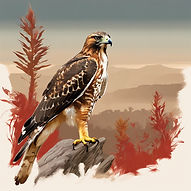

CHIA
California Habitat for Indigenous Arts

WHO WE ARE
California Habitat for Indigenous Arts (CHIA) a cultural organization dedicated to supporting and promoting indigenous artistic heritage and contemporary expressions within the state of California. Including initiatives such as artist residencies, exhibitions, workshops, cultural exchanges, advocacy for indigenous artists' rights, and collaborations with indigenous communities to preserve and celebrate their cultural heritage through the arts.
Our mission is to preserve and revitalize the traditional arts and culture of California's Indigenous communities. Through a range of initiatives and projects, we are dedicated to improving the well-being, prosperity, and cultural identity of California's Indigenous people. By honoring and celebrating our rich cultural heritage, we aim to foster a vibrant and inclusive community that values and respects Indigenous traditions, ensuring their continuation for future generations.
The acronym CHIA stands for "California Habitat for Indigenous Arts."
• California: California was a land of rich cultural diversity, inhabited by numerous Native American tribes such as the Chumash, Miwok,Ohlone and Kummeyaay who lived in harmony with the environment through sustainable practices like hunting, fishing, and gathering. Their intricate social structures, spiritual beliefs deeply rooted in nature, and artistic expressions, such as intricate basketry and storytelling, left a profound legacy that continues to influence the cultural fabric of the state. Today, California remains a melting pot of cultures, boasting stunning natural beauty from picturesque beaches to towering mountains, alongside being a global hub for technological innovation, exemplified by Silicon Valley, and a vibrant urban landscape alive with diverse communities and cultural expressions.
• Habitat: The term "habitat" typically refers to a natural environment where particular species thrive. In the context of an arts organization, it could signify a nurturing environment or ecosystem for indigenous arts to flourish. This might include providing resources, support networks, and opportunities for indigenous artists.
• Indigenous: "Indigenous" refers to groups or peoples who are native to a particular region or land. With a focus on the traditional and contemporary artistic expressions of Native American, First Nations, or other indigenous communities within California.
• Arts: Focussing on various forms of artistic expression, including but not limited to visual arts, performing arts, traditional crafts, storytelling, music, and dance. Art plays a multifaceted and crucial role in society, influencing various aspects of human life, culture, and development.
Chia seeds were a vital source of nourishment, medicine, and spiritual power for the Chumash and other Indigenous peoples of California. Rich in omega-3 fatty acids, protein, fiber, and essential minerals, chia was considered a power food—especially valued during long trade expeditions and journeys. It provided sustained energy, hydration, and strength, making it a trusted staple for travelers. Traditionally, the seeds were roasted, ground into a fine meal, and mixed with cold water to form a nutrient-rich gruel.
Chia also held important medicinal uses. One unique remedy involved placing a whole chia seed under the eyelid to remove foreign particles. As the seed absorbed moisture, it would soften and become gelatinous, naturally adhering to the irritant so that both could be gently drawn out. This simple yet effective method reflects the deep botanical knowledge embedded in Chumash traditional ecological practices.
Beyond its physical and medicinal value, chia held spiritual significance. Seeds were offered in prayer, placed at sacred sites, or gifted during ceremonies—symbolizing nourishment, gratitude, and reciprocity with the Earth. As they traveled, Chumash traders would also scatter chia seeds along the paths and trails, ensuring that the plant would continue to grow for future generations. This act of seeding the land was a gesture of respect and care, sustaining both people and ecosystems through an enduring relationship with the natural world.